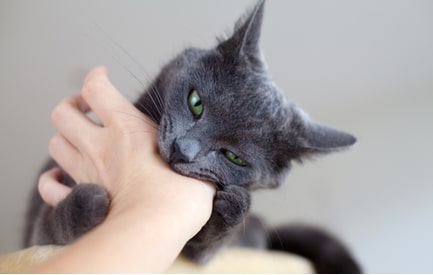
Has your cat ever grabbed your hand and bit you? Maybe they’re loving a tummy rub until, suddenly, your hand is in their paws and their kicking and biting at it.
Most of us don’t enjoy being bitten by our cats. The first step to stopping this behavior is to learn why they’re biting in the first place. Here are some reasons your cat might grab your hand and bite you:
- You use your hand as a toy, so your cat doesn’t know better
- Your cat wants to play and needs to be redirected to a toy
- Your cat is annoyed and wants to be left alone
- You’re petting your cat in a way they don’t like
- Your cat is injured
Many of these should be obvious if you know your cat well. Pay attention to their body language, and if a specific situation is causing them to bite, stop putting your cat in that position.
Other situations might be more difficult to spot, especially if you don’t know how to read cats very well. In this article, I’ll discuss why your cat may be biting and how to get them to stop.
Your Cat Doesn’t Realize That Your Hand Isn’t a Toy
Too many people think it’s okay to allow cats to play with their hands—especially as kittens. The truth is, you’re encouraging behavioral problems when you do this.
While it might be cute for a kitten to gnaw at your hand when they’re tiny, it probably won’t be as they get older.
The same goes for playtime. If it’s okay for your cat to bite your hand when you want to play, you better be okay with them biting it all of the time. They will not learn the difference.
In my house, the rule is simple: my cats’ teeth do not touch me, ever.
The reason for this is that I don’t want to be bit, and I know how cats learn. Punishing your cat when they bite only sometimes gives them mixed signals, and they won’t understand why you’re angry.
When cats feel they’re being scolded for no reason, it only serves to damage your relationship with them. It won’t actually change their behavior.
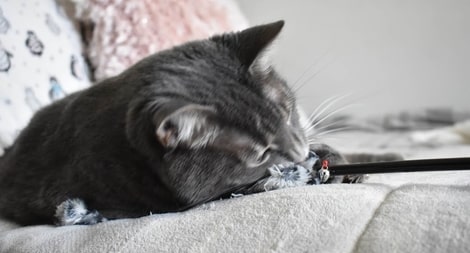
My cat, Pepper, playing with a wand toy
Your Biting Cat Probably Wants to Play
Most times, a cat who’s grabbing and biting your hand is simulating hunting behavior. If your cat were to catch prey, they would bite and scratch at it in this way to tear it apart.
That’s not to say your cat really wants to hurt or kill you—they don’t! They’re just doing something that’s instinctual to them.
Luckily, there are better ways to simulate hunting instincts for your cat, such as playtime.
You should play with your cat from 30-45 minutes a day to keep them healthy and active. Break playtime into 10-15 minute increments, as your cat likely won’t want to play for a half-hour straight.
I time play sessions right before each meal, but other great times to play with your cat are before leaving for work or before bedtime.
Your cat should also have toys around the house that they can play with on their own. Mine love their stuffed catnip toys and this tower of tracks toy the best, but it’s great to have a variety to keep your furry friends busy.
Catnip toys are especially useful because they can be grabbed and bitten as an alternative to your hand.
The Best Way to Stop a Biting Cat who wants to play is to ignore them
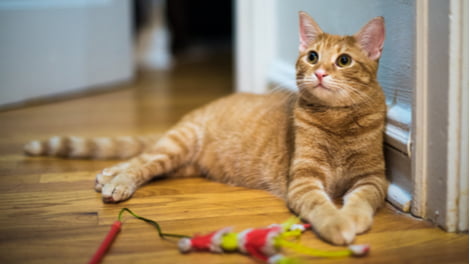
It may be tempting to smack or scream at your cat for biting, but that really isn’t the most effective way to handle the situation.
In most cases, you should pull your hand away from your cat and gently push them away or set them on the floor away from you. Ignore them for a while so that they understand that biting doesn’t get them attention.
If you can’t physically move your cat without getting bitten again, walk away from the situation yourself. The point is to put distance between you and your cat, and to show that biting isn’t the way to get your attention.
If your cat has latched onto your hand and won’t let go, try not to pull away. I know it’s instinctual to do so, but it’s actually better to push your hand into the bite to make your cat let go.
Your Cat Might be annoyed
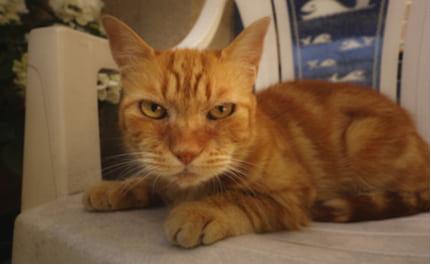
My cat Dusty will meow and meow to be pet. “Pay attention to me!” he’ll scream at random from the bedroom where he spends most of his time.
I walk in and pet him, and all is well at first. Until his paw begins to wrap around my hand.
Dusty is twelve years old, and we adopted him when he was four. I now know him well enough to walk away the moment he grabs my hand with his paw, because it means he’s done being pet.
If I don’t draw away, his next step will be to bite.
Some cats can be finicky, wanting attention one moment and changing their minds the next. The key is to look at their body language.
What do they do as they begin to grow annoyed? What does it look like when they’re about to bite you?
Do they always bite when you touch the same place, such as their stomach, tail, or feet?
Cats can’t speak English, so we can’t necessarily blame them for communicating in the ways they know how. We also can’t let them bite us constantly, so it’s up to us to work with them rather than against them.
Once you know the signs of your cat not wanting to be touched, respect their boundaries. Don’t try to push and force them to continue being handled when it’s unnecessary.
That will only make them, and probably you, miserable.
Your Cat Bites when being groomed
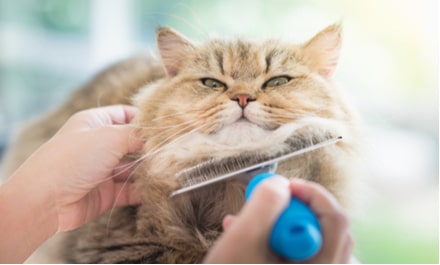
If your cat is grabbing your hand and biting you during grooming, this can turn into a huge problem. I’ve been bitten in this way while trimming cats’ claws and while brushing them.Both of these things need to be done regularly.
The first step is to make sure you aren’t hurting your cat. Do you know how to properly trim a cat’s nails?
If not, you could be causing them great pain. No wonder they’re biting and struggling to get away!
The same goes for combing long-haired cats. If you don’t do so regularly, they’re bound to have knots, tangles, and even mats. These pull at their skin and make combing hurt.
Once you’ve learned how to groom your cat without hurting them, keep in mind that it will take time to regain their trust. Try to stay calm and patient during the process—or, if you need to, hand it over to a professional.
If you know you’re not hurting your cat and they’re just being fussy, try splitting grooming time up throughout the day. I have four long-haired cats, and I typically brush them until I can tell they’re fed up with me. At that point, I move onto the next cat.
A couple of them are less tolerant of long grooming sessions, and so I brush them a little in the morning, and a little at night.
Your Cat May Have an Injury
If your cat is biting suddenly and this isn’t normal behavior for them, consider that they may have an injury or feel ill. This is most likely to occur in older cats, but can happen at any age.
If you have a sore arm and someone won’t stop touching it, you’re likely to lash out. Your cat could be doing the same.
Check them for signs of visible injuries, such as a cut or a limp.
As with any time your cat’s behavior changes suddenly, if you can’t find the cause, you should bring them to your veterinarian.
Treating Cat Bites that Pierce Skin
Cat bites come with a high risk of infection, so it’s important to take them seriously.
After being bit, wash your hand thoroughly, but don’t scrub it. If you’re bleeding heavily, apply pressure to the wound.
If the bite is deep, or you develop a fever or flu-like symptoms, you should see a doctor. They will give you antibiotics to prevent a severe infection.

I am a freelance writer who specializes in the pet industry. My full bio
References
- https://www.thesprucepets.com/stop-cat-bites-553893#:~:text=If%20your%20cat%20bites%20and,and%20nailing%20your%20bare%20legs.
- https://pets.webmd.com/cats/guide/cat-nail-clipping-care
- https://www.petmd.com/cat/behavior/causes-sudden-aggression-cats
- https://vcahospitals.com/know-your-pet/wounds-cat-bite-injuries-to-humans
- https://www.petmd.com/cat/training/evr_ct_how-to-stop-cat-from-biting
- https://www.humanesociety.org/resources/teach-your-kitten-how-play-nice